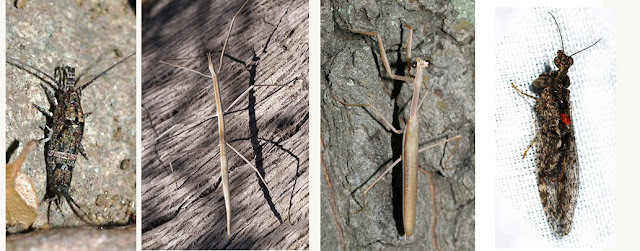On the north side of the Catalina Mountains a service road connects the town of Oracle to the top of Mount Lemmon. Connecting may be the wrong term. None of my vehicles seems appropriate to negotiate the steep rocky, barely maintained road. The entrance to Peppersauce Canyon, however, is on the lower part of the road that is smooth and easy to drive. Last week Jeff Eble, a college from the entomology department, and two students asked me (and my black light) to join them on a collection trip. Jeff wants to study genetic shifts among isolated beetle populations of the sky islands, so he is mainly interested in flightless species that can't mingle as much as their more mobile counterparts.
Black lights, of course, draw the good fliers first. That evening, we were immediately inundated by hundreds of
Phyllophaga vetula, a chunky, hairy June beetle. Scores of
Anomala delicata followed soon after.
Soon a bristletail and a stick insect walked up, and a slim beige Mantis with surprisingly dark eyes, and a mantispid came to prey on 'our' bugs.
The most common Cerambycid was
Methia mormona (top, middle), but we were also visited by a huge
Prionus heroicus (left), several delicately spotted
Orwellion gibbulum arizonense (right) and a tiny
Sternidus decorus mMiddle, bottom). A number of Bycids in the the genera Aneflus and Oeme are still unidentified.
Weevils were represented by two Curculio spp (left). and the broadnose weevil
Pandeleteius buchanani.
Surprisingly several Sunburst Beetles
Thermonectus marmoratus (right) and two Whirligig Beetles
Dineutus sublineatus (left), all living in shallow ponds, showed up. We couldn't find any water close by, but the beetles are good fliers who often approach shiny surfaces like car roofs and lights.
The only carabids appearing in numbers looked like Selenophorus which we ignored because they are impossible to id. We also got several specimens of a tiny Bombadier Beetle that hopefully will be a new species for me. Jeff collected Lebia mimics of the Bombadier Beetles even though they do fly - he needs some control groups for his flightless stuff.
Walking along the trail with flash lights, we found two larger cerambycids,
Enefalodes hispinicornis and a Prionid. Both are good fliers, so I got them for my photo collection.
Jeff was happy with his collection of large flightless Darkling Beetles like
Eleodes subnitens and
longicollis on the trail, and
Strongylium atrum (above)
on tree trunks.
We also found several very attractively shaped
Embaphion sp. I hope to keep one of them alive and happy for the U of A Beetle festival on the 27th of September (Tucsonans, mark your calendars!).
Windscorpions (Solifugiae) were racing about at top speed, with Jeff in hot pursuit.
Under a rocky overhang an impressive Cat-faced Orbweaver,
Araneus illaudatus, was hanging out in her over 20 in wide net.
Meanwhile at the black light, interesting moths had arrived: Clock-wise:
Manduca rustica, Gerrodes minatea, Euclidia diagonalis, Syssphinx hubbardi, Datana sp.
While we were observing arthropods, fellow vertebrates were spying on us: A Woodhouse's Toad, two Gray Foxes and a gang of Havelinas took their turns.
Maybe we were set up right in the path of their evening rounds.























































